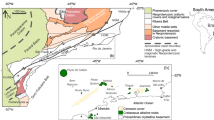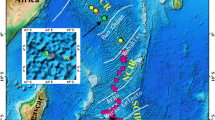Abstract
Surface samples of peridotites and hornblendite mylonites from St. Paul's Rocks, and dredge samples from the flanks of the massif, have been analyzed for Sr, Nd and Pb isotopic ratios and Rb, Sr, and REE concentrations. This data, coupled with previous K and REE data, are used to develop a self-consistent model for the genesis of these ultramafic rocks. This model involves metasomatism of an ocean island-type mantle about 155 m.y. ago by a strongly light-REE-enriched metasomatic fluid, probably derived from the same mantle. This metasomatism produced light-REE-enriched materials which were isotopically homogeneous on a small scale (100 m), and isotopically heterogeneous on a large (km) scale. The geochemical relationships between the peridotites and the hornblendites were established by metamorphic equilibration on a relatively small scale (<10 m). The “average” mantle produced by these events is characterized by87Sr/86Sr=0.7034,143Nd/144Nd=0.51291,206Pb/204Pb=19.33 and 207/204=15.63. An alkali basalt which postdates the mylon-itization of the ultramafic massif has an isotopic character which is identical to the “average” ultramafic massif; it also lies on the five-dimensional isotopic mantle plane of Zindler et al. (1982). With respect to major elements, trace elements, and Sr, Nd and Pb isotopes, the average ultramafic rock of the St. Paul's massif is an ideal candidate for a mantle source from which alkali basalts can be derived by partial melting; the St. Paul's massif is in fact the first such example of an ultramafic rock which meets all the requirements to be an alkali basalt source.
Similar content being viewed by others
References
Boettcher AL, O'Neil JR (1980) Stable isotope, chemical and petrographic studies of high pressure amphiboles and micas: evidence for metasomatism in the mantle source regions of alkali basalts and kimberlites. Am J Sci 280:594–621
Bonatti E, Hamlyn P, Ottonello G (1981) Upper mantle beneath a young oceanic rift: peridotites from the island of Zabargad (Red Sea). Geology 9:474–479
Carlson RW, Macdougall JD, Lugmair GW (1978) Differential Sm/Nd evolution in oceanic basalts. Geophys Res Lett 5:229–232
Cohen RS, Evensen NM, Hamilton PJ, O'Nions RK (1980) U-Pb, Sm-Nd and Rb-Sr systematics of mid-ocean ridge basalt glasses. Nature 283:149
Dickey JS, Jr, Obata M, Suen CJ (1979) Chemical differentiation of the lower lithosphere as represented by the Ronda ultramafic massif, Southern Spain. In: Ahrens LH (ed)Origin and Distribution of the Elements. Pergamon Press, Oxford, pp 587–595
De Paolo DJ, Wasserburg GJ (1976) Inferences about magma sources and mantle structure from variations of143Nd/144Nd. Geophys Res Lett 3:743–746
Dosso L, Murthy VR (1980) A Nd isotopic study of the Kerguelen Islands: Inferences on enriched oceanic mantle sources. Earth Planet Sci Lett 48:268–276
Dupre B, Allegre CJ (1980) Pb-Sr-Nd correlation and the chemistry of the North Atlantic mantle. Nature 286:17–22
Frey FA (1983) Rare earth element abundances in upper mantle rocks, p. 153–203. In: Henderson P (ed)Rare Element Geochemistry. Elsevier, Amsterdam
Frey FA (1970) Rare earth and potassium abundances in St. Paul's Rocks. Earth Planet Sci Lett 7:351–360
Frey FA, Prinz M (1978) Ultramafic inclusions from San Carlos, Arizona: petrologic and geochemical data bearing on their petrogenesis. Earth Planet Sci Lett 38:129–176
Frey FA, Green DH (1974) The mineralogy, geochemistry and origin of lherzolite inclusions in Victorian basanites. Geochim Cosmochim Acta 38:1023–1059
Greenwood HJ (1961) The system NaAlSi2O6-H2O-Argon: total pressure and water pressure in metamorphism. J Geophys Res 66:3923
Harrison WJ (1981) Partitioning of REE between minerals and coexisting melts during partial melting of a garnet lherzolite. Am Mineral 66:242–259
Hart SR (1976) LIL-element geochemistry, leg 34 basalts. In: Yeats RS, Hart SR (eds) Initial Reports of the Deep Sea Drilling Project, Volume XXXIV, Washington, D.C. (US Government Printing Office) 283–288
Hart SR, Brooks C (1977) The geochemistry and evolution of early Precambrian mantle. Contrib Mineral Petrol 61:109–128
Hart SR, Brooks C (1974) Clinopyroxene-matrix partitioning of K, Rb, Cs, Sr and Ba. Geochim Cosmochim Acta 38:1799–1806
le Roex AP, Dick HJB, Erlank AJ, Reid AM, Frey FA, Hart SR (1983) Geochemistry, Mineralogy and Petrogenesis of lavas erupted along the southwest Indian Ridge between the Bouvet triple junction and 11 degrees east. Contrib Mineral Petrol 24:267–318
Lindsley DH, Andersen DJ (1983) A two-pyroxene thermometer. Geophys Res 88:A887-A906
Lloyd FE, Bailey DK (1975) Light element metasomatism of the continental mantle: the evidence and consequences. Phys Chem Earth 9:389–416
Loubet M, Allegre CJ (1979) Trace element studies in the Alpine type peridotite of Beni Bousera (Morocco). Geochem J 13:69–75
Machado N, Ludden JN, Brooks C, Thompson G (1982) Fine-scale isotopic heterogeneity in the sub-Atlantic mantle. Nature 295:226–228
Manhes G, Minster JF, Allegre CJ (1978) Comparative uranium-thorium-lead and rubidium-strontium of St. Severin amphoterite: consequences for early solar system chronology. Earth Planet Sci Lett 39:14–24
Melson WG, Hart SR, Thompson G (1972) St. Paul's rocks, equatorial Atlantic: petrogenesis, radiometric ages and implications on sea-floor spreading. Geol Soc Am 132:241–272
Menzies M, Murthy VR (1980) Nd and Sr isotope geochemistry of hydrous mantle nodules and their host alkali basalts: implications for local heterogeneities in metasomatically veined mantle. Earth Planet Sci Lett 46:323–334
Mysen BO (1979) Trace-element partitioning between garnet peridotite minerals and water-rich vapor: experimental data from 5 to 30 kbar. Am Mineral 64:247–287
O'Nions RK, Hamilton PJ, Evensen NM (1977) Variations in143Nd/144Nd and87Sr/86Sr ratios in oceanic basalts. Earth Planet Sci Lett 34:13–22
Ottonello G (1980) Rare earth abundances and distribution in some spinel peridotite xenoliths from Assab (Ethiopia). Geochim Cosmochim Acta 44:1885–1901
Philpotts JA, Schnetzler CC, Thomas HH (1972) Petrogenetic implications of some new geochemical data on eclogitic and ultrabasic inclusions. Geochim Cosmochim Acta 36:1131–1166
Richard P, Shimizu N, Allegre CJ (1976)143Nd/144Nd, a natural tracer: an application to oceanic basalts. Earth Planet Sci Lett 31:269–278
Richardson SH, Erlank AJ, Duncan AR, Reid DL (1982) Correlated Nd, Sr and Pb isotope variation in Walvis Ridge basalts and implications for the evolution of their mantle source. Earth Planet Sci Lett 59:327–342
Roden MF, Frey FA, Francis DM (1983) An example of consequent mantle metasomatism in peridotite inclusions from Nunivak Island, Alaska. (submitted) J Petrol
Schilling JG, Bergeron MB, Evans R (1980) Halogens in the mantle beneath the North Atlantic. Phil Trans R Soc London 297:147–178
Sheppard SMF, Epstein S (1970) D/H and18O/16O Ratios of minerals of possible mantle or lower crustal origin. Earth Planet Sci Lett 9:232–239
Sinton JM (1979) Ultramafic inclusions and high-pressure xenocrysts in submarine basanitoid, equatorial mid-Atlantic ridge. Contrib Mineral Petrol 70:49–57
Stakes DS, O'Neil JR (1982) Mineralogy and stable isotope geochemistry of hydrothermally altered oceanic rocks. Earth Planet Sci Lett 57:285–304
Stosch HG (1982) Rare earth element partitioning between minerals from anhydrous spinel peridotite xenoliths. Geochim Cosmochim Acta 46:793–811
Sun SS (1980) Lead isotopic study of young volcanics from midocean ridges, ocean islands and island arcs. Phil Trans R Soc 297:409–445
Tatsumoto M (1978) Isotopic composition of lead in oceanic basalt and its implication to mantle evolution. Earth Planet Sci Lett 38:63–87
Thompson G (1981) St. Peter and St. Paul's rocks (equatorial Atlantic) and the surrounding sea floor. Woods Hole Oceanogr Inst Tech Rept WHOI-81-98
Wass SY, Henderson P, Elliott CJ (1980) Chemical heterogeneity and metasomatism in the upper mantle: evidence from rare earth and other elements in apatite-rich xenoliths in basaltic rocks from eastern Australia. Phil Trans R Soc 297:333–346
Wendlandt RF, Harrison WJ (1979) Rare earth partitioning between immiscible carbonate and silicate liquids and CO2 vapor: results and implications for the formation of light rare earth-enriched rocks. Contrib Mineral Petrol 69:409–419
White WA, Hofmann AW (1982) Sr and Nd isotope geochemistry of oceanic basalts and mantle evolution. Nature 296:821–825
White WA, Hofmann AW (1978) Geochemistry of the Galapagos Islands: implications for mantle dynamics and evolution, Carnegie Inst Wash Yearb 77:596–606
Wilshire HG, Pike JN (1975) Upper mantle diapirism: evidence from analoguous features in alpine peridotite and ultramafic inclusions in basalt. Geology 3:467–470
Wiseman JDH (1966) St. Paul rocks and the problem of the upper mantle. Geophys J Roy Astr Soc 2:519–525
Varne R, Graham AL (1971) Rare earth abundances in hornblende and clinopyroxene of a hornblende lherzolite xenolith: implications for upper mantle fractionation processes. Earth Planet Sci Lett 13:11–18
Zindler A (1980) Geochemical processes in the earth's mantle and the nature of crust-mantle interactions: evidence from studies of Nd and Sr isotope ratios in mantle-derived igneous rocks and lherzo-lite nodules. Ph D Thesis, Massachusetts Institute of Technology
Zindler A, Jagoutz E (1980) Isotope and trace element systematics in mantle-derived peridotite nodules from San Carlos. EOS, 61(197):374
Zindler A, Jagoutz E, Goldstein S (1982) Nd, Sr, and Pb isotopic systematics in a three-component mantle: a new perspective. Nature 298:519–523
Zindler A, Hart SR, Frey FA, Jakobsson SP (1979) Nd and Sr isotope ratios and rare earth element abundances in Reykjanes Peninsula basalts: evidence for mantle heterogeneity beneath Iceland. Earth Planet Sci Lett 45:249–262
Author information
Authors and Affiliations
Rights and permissions
About this article
Cite this article
Roden, M.K., Hart, S.R., Frey, F.A. et al. Sr, Nd and Pb isotopic and REE geochemistry of St. Paul's Rocks: the metamorphic and metasomatic development of an alkali basalt mantle source. Contr. Mineral. and Petrol. 85, 376–390 (1984). https://doi.org/10.1007/BF01150294
Received:
Accepted:
Issue Date:
DOI: https://doi.org/10.1007/BF01150294




